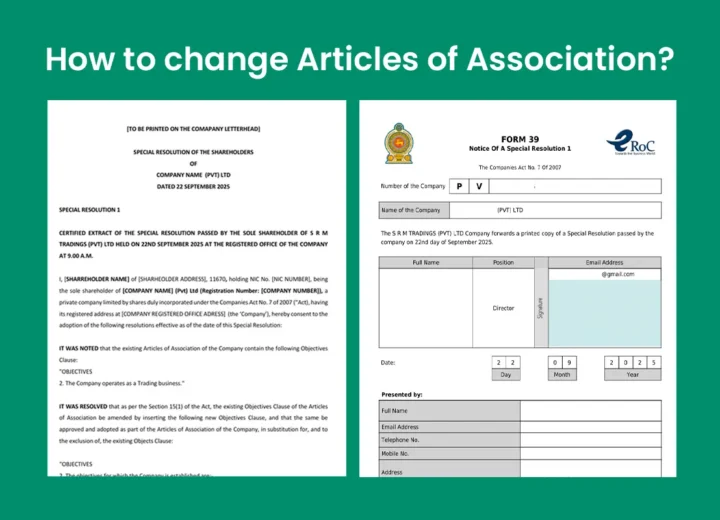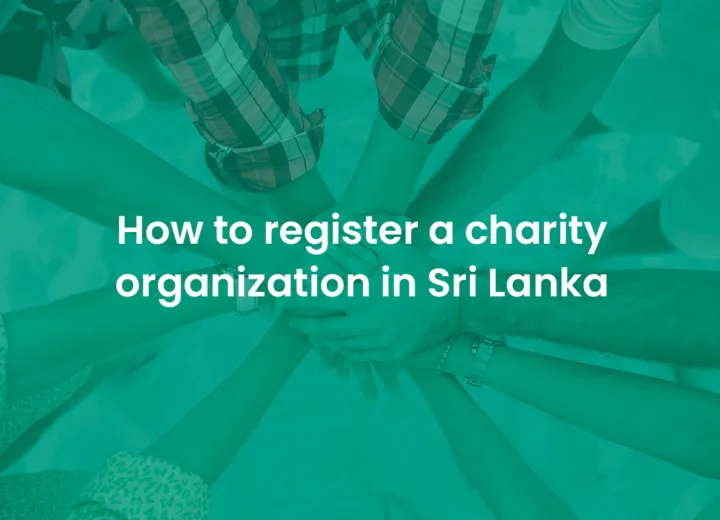You’ve worked so hard to create your brand. But what if someone else registers your brand name or logo and claims it as their own? This is why trademark registration in Sri Lanka is so important. By registering your logo as a trademark you can protect your brand against copycats and let everyone know that your brand is off-limits.
Whether you’re a sole proprietor, partner, or a company, anyone can apply for trademark registration in Sri Lanka. The National Intellectual Property Office of Sri Lanka (NIPO Sri Lanka) administers and processes trademark registrations in Sri Lanka. Currently, there is no system for trademark registration online in Sri Lanka and all applications must be submitted in person.
Trademark registration might sound complicated, but it’s actually quite simple. This beginner’s guide will walk you through the trademark registration process in Sri Lanka step by step, breaking it down into simple, actionable steps. By the end of this guide, you’ll know exactly how to register your trademark in Sri Lanka and why it’s a smart move for your business.
Register your trademark for only 11,499 LKR and enjoy the most reasonable trademark registration fees in Sri Lanka.
Table of Contents
6 Steps to Trademark Registration in Sri Lanka
The basic steps to registering a trademark in Sri Lanka include doing an initial trademark clearance search, filing trademark registration forms with the NIPO, and monitoring your application during the trademark examination stage.
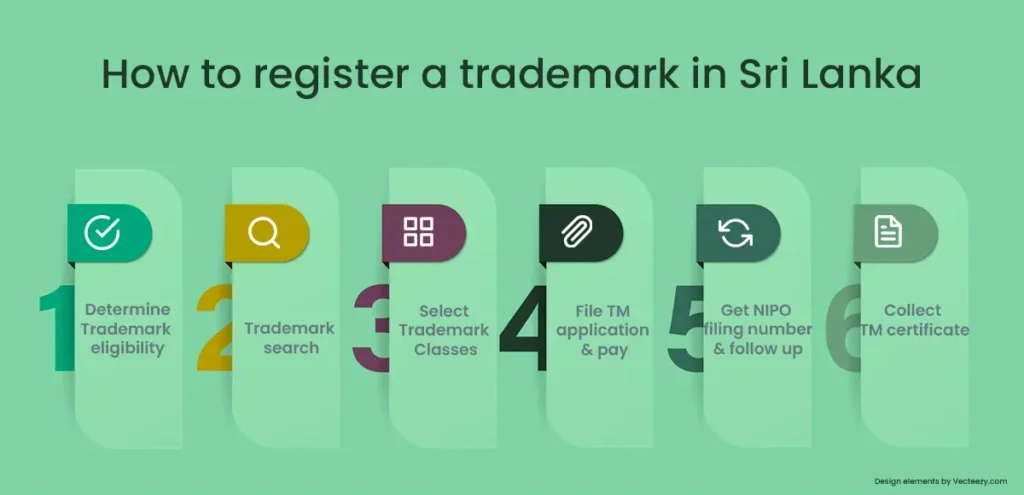
1. Choose a trademark that qualifies for trademark protection
Only word marks and device marks can be registered as trademarks under the Intellectual Property Act No. 36 of 2003. A word mark is simply a brand name, slogan, or tagline made up of words, letters, or numbers. A device mark is a visual representation like a logo, picture, drawing, or symbol, which can include a combination of words and a design.
You can’t register non-traditional trademarks like colors, shapes, videos, sounds, tastes, textures, or holograms as trademarks in Sri Lanka.
2. NIPO trademark search
Trademark search is the first step in brand registration. It checks the availability of your trademark for registration and determines whether your mark conflicts with the rights of a trademark owner who filed before you. You cannot register a trademark similar or identical to a mark already registered in the Sri Lanka trademark database. A comprehensive trademark clearance search can help you avoid potential opposition or objections during the registration process.
After you do a trademark search on your own using the internet, make sure to do a final search for similar trademarks in the NIPO Sri Lanka trademark database to confirm whether anyone else owns or has applied for a mark that is similar in wording/design under related goods/services.

Registering your trademark and registering your company name aren’t the same thing. Trademarking your brand name does not grant you ownership rights to reserving your company name or matching your domain name. Another business entity might already be registered under your brand name with Registrar of Companies. This is why you should cross-check your brand name with the eROC company name register before filing for trademark registration.
3. Select applicable Trademark classes in Sri Lanka
It is important to identify the precise trademark class or classes to which your mark will apply. The International Classification of Goods and Services (also called the Nice Classification) categorizes goods into classes 1-34 and services into classes 35-45.
Trademark registration in Sri Lanka is limited to single-class applications. This means you’ll need to file a separate application for each class of goods or services for which you intend to register your mark. NIPO Sri Lanka does not accept multi-class applications.
For example, you want to register your brand name for clothing (Class 25) and retail store services (Class 35). Since Sri Lanka only allows single-class applications, you’d need to file two separate applications—one for clothing under Class 25 and another for retail services under Class 35. The more classes you register, the more it’ll cost, and the trademark registration process will take longer, as each class needs to go through the examination stage before approval.
4. Fill out the application form and pay the trademark registration fees
The trademark registration form is a simple, two-page document. You’ll need to include the applicant’s name, address, and email (this can be you or your company or partnership, depending on who’s applying). Your trademark registration application should accompany a representation of the mark. You must include a not more than 10 cm * 10cm size clear depiction of the trademark you want to register printed on an A4 sheet or pasted onto the application form.
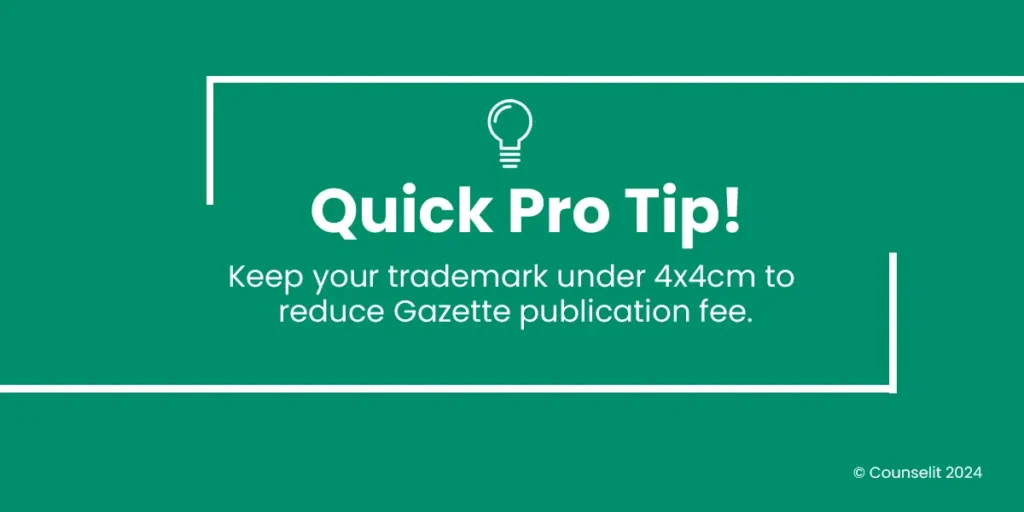
You’ll also need a translation of the mark certified by a sworn Translator if the mark consists of a word or words not in Sinhala, Tamil, or English.
You can also choose to claim specific colors for your trademark or opt not to claim any colors with a simple black-and-white representation of the mark.
Suppose you’ve showcased goods or services under your trademark at an official international exhibition. In that case, you can apply for registration in Sri Lanka within six months and claim priority from the exhibition date. You’ll be asked to provide a certificate from the exhibition authority confirming when the mark was first used.
If you’ve already filed a trademark application in a Paris Convention country, you can file a priority trademark application in Sri Lanka within six months of the original filing date. You must also submit a written declaration to support your priority claim (priority document). This declaration should include the date and number of the earlier application, the applicant’s name, and the country where the application was filed. You must provide a certified copy of the earlier application within three months of filing in Sri Lanka, verified by the relevant authority in that country.
Let’s say you file for a trademark in India, and then later want to file in Sri Lanka. Because you filed in India first, that’s considered your priority filing date for other countries, including Sri Lanka.
Sri Lanka is not part of the Madrid system. This means if you are a Sri Lankan exporter wanting to register your brand in the US, you cannot apply for a USPTO trademark based on your Sri Lanka-registered trademark through the World Intellectual Property Organization (WIPO). You would need to apply for a US trademark through a separate application filed with the US trademark office.
According to DailyFT, the Attorney General’s Department is currently reviewing the draft bill for joining the Madrid Protocol, and NIPO Sri Lanka is waiting for the AG’s opinion.
After completing the application, you or your registered agent can sign it. If you apply as a company, the authorized signature with the company seal (if you’re a Director, you can sign the application form) or the appointed agent’s signature is required. Where the application is made through an agent, your application should accompany a power of attorney granted to the agent.
When submitting your trademark application, you’ll be asked to provide two photocopies of the completed form. One copy is for official use, and the other will be returned to you for reference.
The trademark registration application fee is a processing fee. Not all applications result in registrations. However, the fee will not be refunded, even if your application is refused.
5. Get the NIPO filing number and follow up on your application
Once you hand in the application form, one of the photocopies you provided will be returned to you with a reference number acknowledging your application. You will need this reference number when following up on your application.
Following up on your trademark registration application, it is important to confirm if your trademark is accepted, rejected, or any oppositions have been filed. If NIPO decides your mark isn’t eligible for registration, they’ll notify you of the reasons for refusal. If you disagree with their decision, you can file a written objection within one month. After reviewing submissions, NIPO may either accept your application, accept it subject to conditions, or reject it. If accepted, they will ask you to pay a publication fee to publish your mark in the gazette. Once you pay the fees, your mark will be published opening for objections from the public.
If someone believes the mark is inadmissible, they can file an opposition with NIPO within three months of publication. If opposition is filed, you can respond with evidence within three months. After reviewing the opposition and your responses, NIPO will decide whether to register the mark. You can file an appeal against the NIPO decision to the Commercial Court within 6 months of the decision. If no opposition is filed, your mark will be registered.
6. Collect your Trademark registration certificate
After your trademark is successfully registered, you’ll receive a certificate that confirms your ownership from the date of filing application. It’s your official proof that you’re the rightful owner of your trademark.
Documents Required for Trademark Registration in Sri Lanka
Whether you apply as a sole proprietor, partnership, local or foreign company, the following are the documents you will need to register your trademark with NIPO Sri Lanka.
- The original of the duly signed Power of Attorney for the Appointment of Intellectual Property Agent (Required if you’re a foreign applicant or when applying through a trademark agent) Counselit will provide you the POA.
- Copy of the NIC/Passport for individual applicants. Business Registration Certificate for partnerships and Company Incorporation Certificate for companies
- Application for trademark registration
- 2 photocopies of the duly filled application
- Soft copy of the trademark in JPEG/PNG format (not more than 10cm * 10cm in size). If the mark is affixed to a separate A4 sheet, you must provide extra 5 copies.
- A certified copy of the priority document from your first-filed application with an English translation if it’s not in English.
How long does it take to register a trademark in Sri Lanka?
The trademark registration process in Sri Lanka can take anywhere from 12 to 18 months on average, depending on the backlog of trademark applications, the complexity of your mark, and the issuance of office actions.
Validity of Trademark Registration in Sri Lanka
Your registered trademark will be valid for the next 10 years. To maintain your trademark rights, you must renew your registration for a further 10-year period.
Do I need a registered IP agent to register a trademark in Sri Lanka?
- Yes, if you are a foreigner or company domiciled outside Sri Lanka, you must be represented at NIPO by an Attorney-at-Law who is a registered IP agent and licensed to practice in Sri Lanka. You can appoint an IP agent through a Power of Attorney which can be filed alongside your application or at a later stage.
- No, if you are domiciled in Sri Lanka, you do not need to have a registered IP agent. However, we recommend that you work with an Attorney-at-Law who is a registered IP agent to guide you through the trademark registration process in Sri Lanka.
Benefits of Trademark Registration in Sri Lanka
Trademark registration in Sri Lanka is not a legal requirement. Then, why should you register your brand or logo as a trademark at all?
For business owners, trademark registration in Sri Lanka provides valuable legal protections. Registering a trademark gives you exclusive legal ownership of your brand. This means that as the owner of a registered trademark, you will have the exclusive right to use, assign, license, or sell that trademark. If someone infringes your mark you can initiate a trademark infringement lawsuit against them.
A registered trademark also makes it easier to defend your brand in a trademark infringement lawsuit.
Sri Lanka is a first-to-file jurisdiction, meaning the rights to a trademark are given to the person or entity that first registers the trademark with NIPO Sri Lanka. However, unregistered marks (also known as common law trademarks) are protected against unauthorized use under the common law action for passing off and unfair competition.
Unregistered trademarks are designated by the TM symbol. For unregistered service marks, SM is used. Registered trademark symbol R is used for registered trademark logos.
To help you understand when to use ®, ™, and ℠ with your logo, here are some trademark examples.
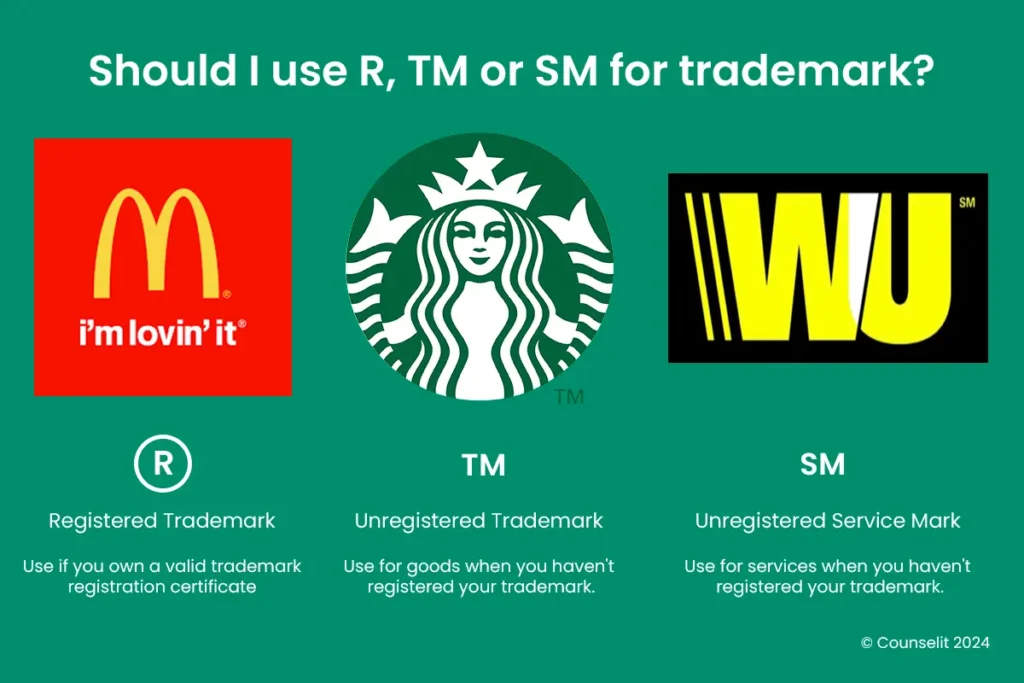
Why register your trademark with Counselit?
Your brand is what sets you apart from your competitors. Every day you wait increases the risk of you never being able to own your brand.
Counselit trademark agents are registered IP agents in Sri Lanka and provide end-to-end brand name registration support, from initial search to final registration. Your trademark agent will assess your brand’s eligibility for a registered trademark and answer any questions you may have about the trademark registration process in Sri Lanka.
Register your trademark today! Starting from just 11,499 LKR. Call us at +94760011066, email at chamalee@counselit.com, or book a call online. Our trademark agents are ready to assist you.
Trademark Registration FAQs
How to register a company logo in Sri Lanka?
A company director or an authorized person can fill in and sign the trademark registration application form which can be downloaded from the NIPO Sri Lanka website. Submit your application with the company logo design (or representation of trade name). Once you pay the trademark registration fee, obtain the filing number from NIPO, and your application will then proceed to the trademark examination stage.
How do I check if a trademark is available in Sri Lanka?
To check trademark availability in Sri Lanka, a manual search at the National Intellectual Property Office (NIPO) is required. There is no online trademark database in Sri Lanka. A trademark clearance search costs LKR 135.50 per class.
When can I use a registered trademark symbol?
Legally, you can only use the registered trademark symbol ® once your mark is officially registered with the National Intellectual Property Office and you have received your certificate. While your application is pending or before filing, use the trademark symbol ™ for goods or the service mark symbol ℠ for services.
Can I register a trademark on my own?
Yes, anyone can apply for trademark registration in Sri Lanka directly if you’re a sole proprietor, partner, or company director. However, foreign applicants must use a registered IP agent.
How much is a registered trademark in Sri Lanka?
Trademark registration fees in Sri Lanka vary depending on whether you’re applying as an individual or a company. The trademark registration application government fee is LKR 1,357 for individuals and LKR 4,071 for companies. There are additional fees for trademark search, publication in the gazette, and the issuance of a trademark registration certificate.


